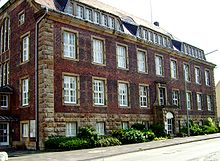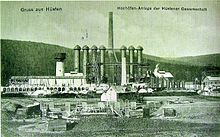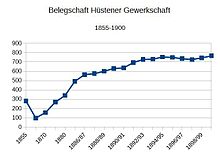Hüstener union
The Hüstener union is a former heavy industrial company in the Sauerland ( 1839 - 1966 ). The main plant was in Hüsten (rolling mill, coke and steel production), subsidiaries in Bruchhausen (city of Arnsberg ) (rolling mill, charring), Brilon-Wald (charring), Soest (rolling mill)
history
Development in the 19th century
Attracted by the availability of sufficient hydropower, a relatively favorable geographical location and low wage costs, a puddle plant was built under the company Joseph Cosack & Co. in 1839 , but it could not last long. The successor to Hüstener union in 1846 was economically more successful.
Both foundations were supported by entrepreneurs and investors from the region and from neighboring areas ( Brandenburg Sauerland and Ruhr area ). These included the Dortmund entrepreneur Wilhelm Overbeck , Friedrich Wilhelm Brökelmann from Neheim , Josef Cosack and the Iserlohn company Kissing & Möllmann . Ferdinand Möllmann's company has held the majority of the shares since the 1840s . Until the 1880s, the actual management of the company was in Iserlohn.
In the first phase of growth, a rolling mill , a hammer mill , a machine factory and other operational parts were added to the puddle mill . At the beginning the company employed about 80 workers, the number rose to 335 by 1851.
In the middle of the 19th century, the Hüsten trade union in its previous form was unable to compete against the advantages of the industrial location in the Ruhr area (near the coal mines). The number of employees fell from 280 (1855) to 98 (1863).
The connection to the Ruhr Valley Railway (1870) had a positive effect in the following years . The parent plant was expanded and subsidiaries in Bruchhausen and Brilon-Wald were added. In 1886 550 and in 1895 750 workers were employed. In comparison with the companies in the Ruhr area, which have since grown into corporations, that was a modest number of employees, but in the area of today's Hochsauerlandkreis the company was one of the largest companies.

The growth phase ended in the 1890s for a variety of reasons; the workforce stagnated.
Large-scale expansion
After the turn of the century, a new phase of expansion began in 1905. Similar to the Ruhr area companies, the Hüstener union was expanded into a large, mixed mining industry. Iron mines were leased in the upper Sauerland, a coking plant , blast furnaces and a Siemens-Martin furnace were built . The ingot and plate rolling mill was also expanded. The workforce jumped to 1,800 men (1911).
The expansion ultimately turned out to be a bad investment. There were technical and quality problems as well as overcapacity. In addition, there was the costly acquisition of the Gabriel & Bergenthal rolling mill in Soest . The company, which was run as a stock corporation , was heavily indebted and could only be restructured with great difficulty. This served u. a. the sale of the profitable chemical charring plants in Bruchhausen and Brilon-Wald.
First World War
During the First World War , the company profited from the war-related demand for products from the coal and steel industry. The profits were substantial and the workforce rose again. However, this also aroused the covetousness of some Ruhr area groups, which had already acquired most of the rolling mills in the Olpe area before the war . Since 1915, negotiations between the company management and Emil Kirdorf from Gelsenkirchener Bergwerks-AG ( GBAG ) had also been underway in Hüsten . In 1916, through a share swap, the company became the property of GBAG. Since then, the company has only been part of one of the largest German industrial conglomerates. At this stage, the new owner was planning to shut down unprofitable parts of the company and concentrate on sheet metal production.
Weimar Republic and end of the metallurgical department
This did not happen at first, of course. Rather, the inflationary economy in the first years of the Weimar Republic and the introduction of the 40-hour week caused a considerable increase in the workforce. In 1922, over 3,000 men were finally employed. After the currency stabilized, it soon became apparent that the previous structure of the Hüsten trade union was hardly competitive. As early as 1925, 400 workers were laid off.
However, the merger of GBAG with some other coal and steel companies to form Vereinigte Stahlwerke AG at the beginning of 1926 was decisive for the company's fate . This involved far-reaching restructuring and rationalization measures. In the course of this development, the previous structure of the company was broken up, numerous parts of the company were broken up and production was concentrated on sheet metal production. As a result, the number of employees also fell considerably and in 1927, at 1,400, was less than half that of 1922.
Part of the Siegerländer Hüttenwerke group
In 1933 the company became part of the Siegener Hüttenwerke as groups within the United Steelworks. Old half-timbered buildings were demolished on the smelter site. The plan was to build new, modern workshops. The outbreak of World War II prevented the implementation of some of the plans. Technical modernization was carried out in 1938 with the construction of a mechanical hot rolling mill. A new marshalling yard and other facilities were also built. With the beginning of the war, production sank due to a lack of labor and raw materials. Similar to the First World War, the workers drafted into the military were replaced by other workers. In addition to women, numerous prisoners of war and forced labor were employed. The sheets produced were important for arms production. The ironworks was the target of bombing raids several times. The heaviest attack took place in March 1945.
Reconstruction and end
The reconstruction took place immediately after the end of the war and production resumed in October 1945. The United Steel Mills was broken up in the early 1950s. In this context, the Hüttenwerke Siegerland group became Hüttenwerke Siegerland AG, to which the Hüsten location also belonged. In 1957, 1200 workers were employed and the factory in Hüsten produced 155,000 t of thin sheet. Productivity, however, lagged behind that of the pre-war period, at least in some areas. Modernizations were carried out to a limited extent. In the course of the structural change in the mining industry, the operation became increasingly unprofitable. The number of employees fell between 1962 and 1965 alone by about half to 600 men. In 1962, Union, AG for mining, iron and steel industry, became the majority shareholder in Hüttenwerke Siegerland. The Union merged with Hoesch AG in 1966 . This had enough rolling mill capacities so that the Hüsten plant was no longer needed. After previous waves of layoffs, operations ceased on July 15, 1966.
Individual evidence
- ↑ Jens Hahnwald: "Golden Twenties?" The stabilization crisis of 1924 and the economic crisis of 1925/26 in the Sauerland. In: Südwestfalenarchiv 12/2012 pp. 316–319
- ^ Rainer Ahlborn: Hüstener Hüttenwerk 1839-1966. In: To Möhne, Röhr and Ruhr. 29/2003 p. 76f.
- ^ Rainer Ahlborn: Hüstener Hüttenwerk 1839-1966. In: To Möhne, Röhr and Ruhr. 29/2003 p. 80f., P. 90
swell
Archival sources can mainly be found in the holdings of the Westphalian Economic Archives in Dortmund (WWA F65). Also in the archive of Thyssen-Krupp AG in Duisburg .
literature
- Rainer Ahlborn: Hüstener Hüttenwerk 1839-1966. In: To Möhne, Röhr and Ruhr. 29/2003 [The journal only contains this article]
- Jens Hahnwald: The Hüstener Union. Plant, workforce and community 1839–1926. In: Hüsten - 1200 years. Contributions to the past and present. Arnsberg 2002, ISBN 3-930264-41-2 , pp. 239-251.
- Walter Lwowski : Investigations into the fate of the Hüstener union. Dissertation, Berlin 1921
- Emmy mark: The history of the Hüsten plant of Hüttenwerke Siegerland AG. Victories 1949.
Coordinates: 51 ° 26 ′ 0.2 ″ N , 7 ° 59 ′ 13.7 ″ E


